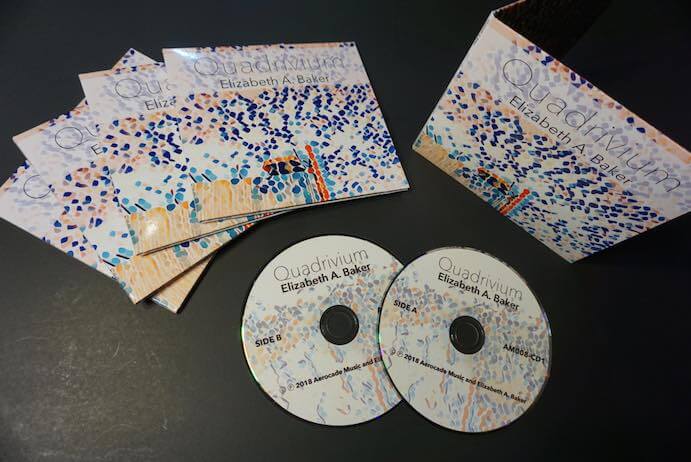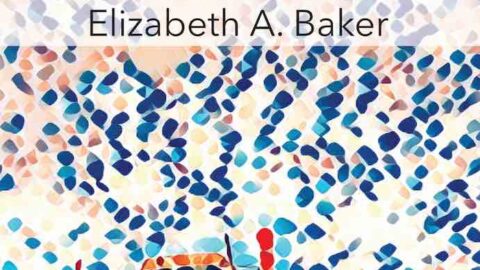In a sprawling solo release of fourteen tracks ranging in length from a half-minute to nearly half an hour, Elizabeth A. Baker inaugurates her Aerocade Music association with Quadrivium, released digitally and as a limited edition double-CD wallet on May 18, 2018. Active as a composer, visual artist, poet, and multi-instrumentalist, Baker wrangles all these pursuits and more together under the label “New Renaissance Artist,” invoking the Leonardos and Galileos of yore in what Baker describes as “a constant stream of change and rebirth in practice […] an exploration of how sonic and spatial worlds can be manipulated to personify a variety of philosophies and principles both tangible as well as intangible.”
Of Quadrivium, she writes: “[The] album name Quadrivium […] ties into my concept of what a new renaissance artist is because it covers arithmetic, geometry, music and astronomy … all subjects that are of interest to me in my creative practice.” And although those on the lookout for a ‘mathematical’ disposition in the music will probably be disappointed—no algorithms here, as far as I can tell—the name’s suggestion of freewheeling ambition certainly checks out.

That ambition has as much to do with scope as scale, and Quadrivium toes the line between plurality and outright messiness in its category-defying zeal. Some tracks are straight-ahead piano solos, from the spacious and Feldman-esque (Sashay, credited to Nathan Anthony Corder) to pointillistic miniatures (Quarks) and noisy improvisations incorporating vibrators placed inside the instrument (Command Voices 251A and 415X). Others abandon the piano entirely, replacing it with dystopian spoken word pieces and New Age synth tracks (these last often remind of 1980s sci-fi scores; think Tron or Terminator). Some of it is not even music. The booklet is devoted not to liner notes but instead to Baker’s original poetry and illustrations, by turns intimate (“walking barefoot on hot coals […] requires bold faith”) and slightly wonkish (“In order to truly know ourselves, we must be willing to deconstruct and evaluate the multitude of pieces that form our identity and our personal reality”).
Both texts and compositions occasionally tend toward a one-dimensionality which blunts their interest: what seems intended as epiphanic often comes off merely as quaint esoterica. One sometimes has a sense of concepts and styles being treated almost as costumes to put on: an easy listening jam session here (in Four Explosions Expanding From The Center), an exposition on psychosis there (in both Command Voices pieces, which somewhat problematically approach phenomena in clinical psychology). Futurist tropes gives the music a semi-narrative thread, but the overall impression is not quite focused: lovely and earnest though they are, the atmospheric soundscapes and existential pronouncements which characterize much of Quadrivium (see tracks like HEADSPACE and Lateral Phases & Beat Frequencies) seem incompletely developed.

Baker promises “a constant stream of change,” however, and delivers on this promise: the “stream” is chaotic, but braided with hopeful distributaries. Quadrivium, with its many conceptual detours and meditations, is uneven. It isn’t always assured, and often favors breadth at the expense of depth. But at its best, it also raises interesting questions around thematic (and personal) interconnectedness: the vibrating undertones of pieces like Command Voices–set alongside the willful inactivity of those like HEADSPACE and An Outcast–strain expectations of unity in more than one sense. Baker’s texts, where present, awkwardly but devotedly engage the same themes of mutuality and cooperation explored by the Renaissance humanists she admires. One feels that the artist’s wide-ranging vision distinguishes the album in a crowded field of conceptual solo debuts, marking her apart as a voice with distinctive potential.
























